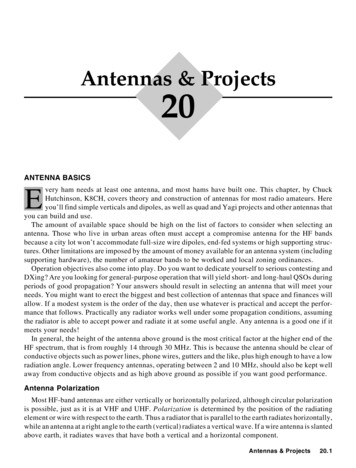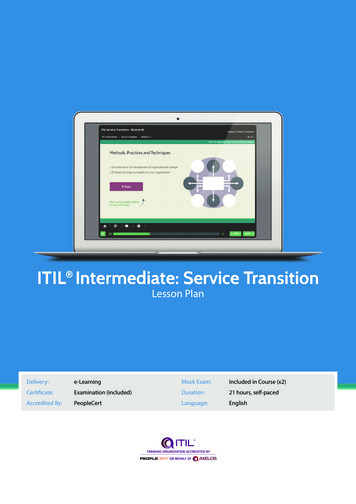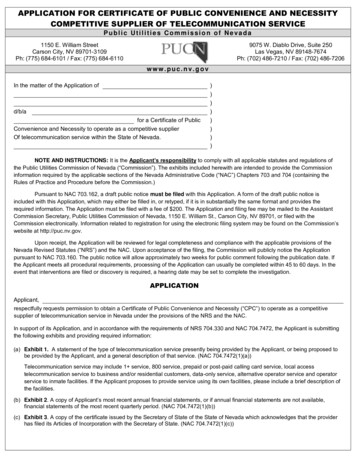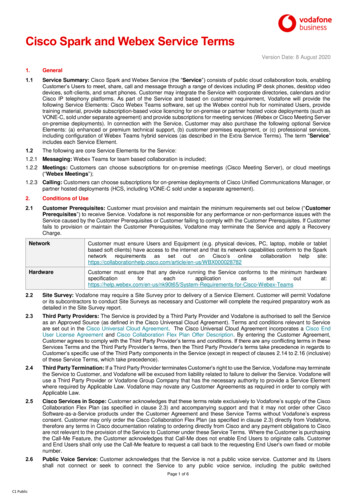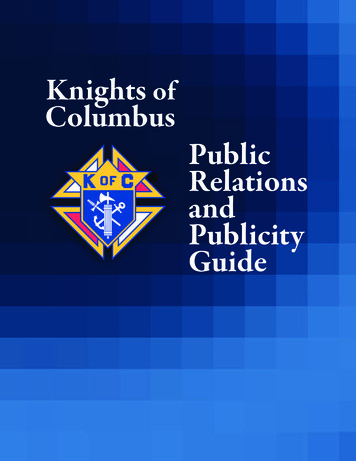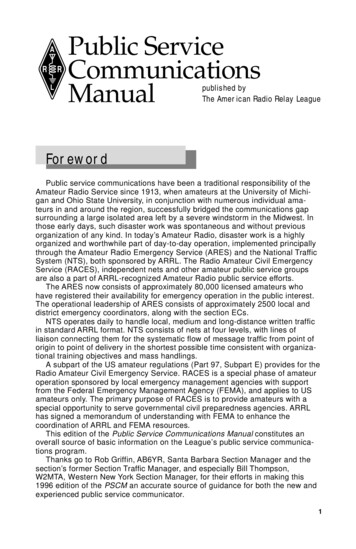
Transcription
ARRLPublic ServiceCommunicationsManualpublished byThe American Radio Relay LeagueForewordPublic service communications have been a traditional responsibility of theAmateur Radio Service since 1913, when amateurs at the University of Michigan and Ohio State University, in conjunction with numerous individual amateurs in and around the region, successfully bridged the communications gapsurrounding a large isolated area left by a severe windstorm in the Midwest. Inthose early days, such disaster work was spontaneous and without previousorganization of any kind. In today’s Amateur Radio, disaster work is a highlyorganized and worthwhile part of day-to-day operation, implemented principallythrough the Amateur Radio Emergency Service (ARES) and the National TrafficSystem (NTS), both sponsored by ARRL. The Radio Amateur Civil EmergencyService (RACES), independent nets and other amateur public service groupsare also a part of ARRL-recognized Amateur Radio public service efforts.The ARES now consists of approximately 80,000 licensed amateurs whohave registered their availability for emergency operation in the public interest.The operational leadership of ARES consists of approximately 2500 local anddistrict emergency coordinators, along with the section ECs.NTS operates daily to handle local, medium and long-distance written trafficin standard ARRL format. NTS consists of nets at four levels, with lines ofliaison connecting them for the systematic flow of message traffic from point oforigin to point of delivery in the shortest possible time consistent with organizational training objectives and mass handlings.A subpart of the US amateur regulations (Part 97, Subpart E) provides for theRadio Amateur Civil Emergency Service. RACES is a special phase of amateuroperation sponsored by local emergency management agencies with supportfrom the Federal Emergency Management Agency (FEMA), and applies to USamateurs only. The primary purpose of RACES is to provide amateurs with aspecial opportunity to serve governmental civil preparedness agencies. ARRLhas signed a memorandum of understanding with FEMA to enhance thecoordination of ARRL and FEMA resources.This edition of the Public Service Communications Manual constitutes anoverall source of basic information on the League’s public service communications program.Thanks go to Rob Griffin, AB6YR, Santa Barbara Section Manager and thesection’s former Section Traffic Manager, and especially Bill Thompson,W2MTA, Western New York Section Manager, for their efforts in making this1996 edition of the PSCM an accurate source of guidance for both the new andexperienced public service communicator.1
Table of ContentsPageForeword1Introduction5Section I: Amateur Radio Emergency Service (ARES)ChapterOne1.11.21.31.41.51.61.71.8Amateur Radio Emergency ServiceARES OrganizationSection LevelLocal LevelDistrict LevelAssistant ECsPlanning CommitteeOperation and FlexibilityARES Operation During Emergencies and DisastersSimulated Emergency Test (SET)Purpose of SETSET FormatPreparing for SETDuring the SETAfter the SETNTS in SETSummary122.12.22.32.42.52.62.7ARES Mutual Assistance Team (ARESMAT) ConceptPre-Departure FunctionsIn-Travel FunctionsArrival FunctionsIn-situ FunctionsPre-demobilization and Demobilization FunctionsARESMAT Member QualificationsSummary143.13.23.33.43.53.63.7ARES and RACESWhat is RACES?Operating ProcedureARES and RACESOther Amateur facilities174.14.24.34.4FiveARES Principles of Disaster Communications19SixWorking With Public Safety Officials21SevenOn Serving “Served” Agencies23TwoThreeFour27
Section II: National Traffic System (NTS)ChapterPageOneNational Traffic SystemMembership in NTSMode261.11.2Principles of NTS OperationLocal NetsSection NetsRegion NetsArea NetsTranscontinental CorpsDigital Stations282.12.22.32.42.52.6NTS PoliciesSequence of Net MeetingsOptionsDeviation from Normal RoutingAdherence to SchedulesAlternate RoutingsCheck-in PolicyBoundariesNomenclatureCombined Section NetsLimited Load CapabilityObservation of TimeFrequenciesManager AppointmentsCertificationSpecial Liaison 133.143.15Operation During DisastersSection Traffic Manager, Net Manager FunctionsRegion Net Manager FunctionsArea Net Manager FunctionsTranscontinental Corps Director FunctionsArea Staff Chairman FunctionsGeneral PolicyHealth and Welfare Traffic384.14.24.34.44.54.64.7TwoThreeFour3
FiveNTS Standard Net ProceduresSection NetsRegion NetsArea NetsSend and Receive StationsMiscellaneous ProceduresSection and Local NTS Traffic NodesHF Digital Stations425.15.25.35.45.55.65.7ARRL Precedences and Handling g Instructions456.16.26.36.46.5Operation of the Transcontinental CorpsTCC Station Functions477.1Operation of the Digital SystemHF Digital NTS OperationsVHF Packet Radio Bulletin Boards518.18.2NTS Traffic RoutingExample of NTS Message RoutingNTS Routing GuideMessage Routing in the Digital Station Network529.19.29.3SixSevenEightNineTenCounting Net Traffic10.1 Net Traffic Count10.2 Individual Traffic Count54ElevenOn Getting More Traffic56AppendixNational Traffic System Terms of Reference574
IntroductionThroughout our history, we amateurs have established a reputation for publicservice communications which is of the greatest importance to our continuedoccupation of frequencies. At first, this service was rendered spontaneously andon an individual basis. As time progressed, the need for and value of organization became evident, resulting in the establishment of organized trunk lines andnet systems; later the Amateur Radio Emergency Service (ARES) and theNational Traffic System (NTS) were formed to complete the organization. TheARRL Field Organization includes the combined facilities of the Amateur RadioEmergency Service, as it has developed since 1935, and the National TrafficSystem, which was begun in 1949.It is significant that Part 97 of the FCC’s Rules and Regulations states, asthe first principle under “Basis and Purpose,” the following:“Recognition and enhancement of the value of the amateur serviceto the public as a voluntary non-commercial communication service,particularly with respect to providing emergency communications.”ARES and NTS exist as the League’s implementation of this basic principle.ARES and NTS have much in common. Every emergency net is bound to be, tosome extent, a traffic net, and every traffic net should be prepared to take onvarious forms of emergency-related communications duties. Emergencyconscious and traffic-conscious operators have this in common: They bothderive their chief reward out of activities, which are directly beneficial not only toAmateur Radio, but also to their communities and country.Implementation: The ARRL Field OrganizationBasic Organization and FunctionsThe organization chart in Figure 1 (page 6) shows how ARES and NTS worktogether from top to bottom. Most ARES nets exist only at the local level, andare tied into NTS at local or section level for integration into the nationalsystem. The overall support for all levels of ARES and NTS is provided by theField Services Department at ARRL Headquarters.Leadership in the emergency division (ARES) is exercised by the SectionEmergency Coordinator and the District ECs and local ECs, as shown; in thetraffic division (NTS) by Section Traffic Manager and by Net/Node Managers atthe local and section levels.Usually, emergency operation is initiated at the local level and is the business of the ARES local Emergency Coordinator. Even if the emergency situationtranscends the local level and becomes of statewide, regional, or even nationalconcern, the immediate situation and what to do about it are primarily theconcern of local ARES officials. Much of the emergency messages and othercommunications will be generated by civic and welfare officials, or at theirrequest, with resulting logistical challenges in effecting their conveyance, andare handed to the ARES for solution.While ARES and NTS are two of the ARRL’s public service organizations, itshould not be concluded that this is all that there is to Amateur Radio publicservice, or that this is the extent of the League’s interest in public servicecommunications. On the contrary, there are many other amateur public serviceoperating groups under different sponsorship which are a vital part of the publicservice function of the Amateur Radio Service. As such, they merit and receivethe League’s recognition and assistance to the extent desired and feasible.5
Fig 1—ARRL ARES/NTS diagram6
Section I:EUR RADTAIOAMThe Amateur Radio Emergency Service(ARES)ARLGVERICEMERENCY SER7
ARES Chapter OneAmateur Radio Emergency Service (ARES)The Amateur Radio Emergency Service (ARES) consists of licensed amateurs who have voluntarily registered their qualifications and equipment forcommunications duty in the public service when disaster strikes. Every licensedamateur, regardless of membership in ARRL or any other local or nationalorganization, is eligible for membership in the ARES. The only qualification,other than possession of an Amateur Radio license, is a sincere desire to serve.Because ARES is an amateur service, only amateurs are eligible for membership. The possession of emergency-powered equipment is desirable, but is nota requirement for membership.1.1 ARES OrganizationThere are four levels of ARES organization—national, section, district andlocal. National emergency coordination at ARRL Headquarters is under thesupervision of the ARRL Field Services Manager, who is responsible for advising all ARES officials regarding their problems, maintaining contact with federalgovernment and other national officials concerned with amateur emergencycommunications potential, and in general with carrying out the League’s policiesregarding emergency communications.1.2 Section LevelAt the section level, the Section EmergencyCoordinator is appointed by the Section Manager(who is elected by the ARRL members in his orher section) and works under his/her supervision.In most sections, the SM delegates to the SECthe administration of the section emergency planand the authority to appoint District and local ECs.Some of the ARRL sections with capable SECsare well-organized. A few have scarcely anyorganization at all. It depends almost entirely onwho the section members have put into office asSM and whom he/she has appointed as SEC.1.3 Local LevelIt is at the local level where most of the realemergency organizing gets accomplished,because this is the level at which most emergencies occur and the level at which ARES leadersmake direct contact with the ARES membervolunteers and with officials of the agencies to beserved. The local EC is therefore the key contactin the ARES. The EC is appointed by the SEC,usually on the recommendation of the DEC.Depending on how the SEC has set up thesection for administrative purposes, the EC mayhave jurisdiction over a small community or alarge city, an entire county or even a group ofcounties. Whatever jurisdiction is assigned, the8Fig 2—Section structure forARES.
EC is in charge of all ARES activities in his area, not just one interest group,one agency, one club or one band.1.4 District LevelIn the large sections, the local groups could proliferate to the point wheresimply keeping track of them would be more than a full-time chore, not tomention the idea of trying to coordinate them in an actual emergency. To thisend, SECs have the option of grouping their EC jurisdictions into logical units or“districts” and appointing a District EC to coordinate the activities of the localECs in the district. In some cases, the districts may conform to the boundariesof governmental planning or emergency-operations districts, while in others theyare simply based on repeater coverage or geographical boundaries. Fig 2depicts the typical section ARES structure.1.5 Assistant ECsSpecial-interest groups are headed up by Assistant Emergency Coordinators,designated by the EC to supervise activities of groups operating in certainbands, especially those groups that play an important role at the local level, butthey may be designated in any manner the EC deems appropriate.1.6 Planning CommitteeThese assistants, with the EC as chairman, constitute the local ARESplanning committee and they meet together from time to time to discussproblems and plan projects to keep the ARES group active and well-trained.There are any number of different situations and circumstances that mightconfront an EC, and his/her ARES unit should be organized in anticipation ofthem. An EC for a small town might find that the licensed amateur group is sosmall that appointing assistants is unnecessary or undesirable. On the otherhand, an EC for a large city may find that even his assistants need assistantsand that sometimes it is necessary to set up a special sub-organization tohandle it. There is no specific point at which organization ceases and operationcommences. Both phases must be concurrent because a living organization is achanging one, and the operations of a changing organization must change withthe organization.1.7 Operation and FlexibilityWe have discussed how a typical ARES unit may be organized. Just whatshape the plan in your locality will take depends on what your EC has to workwith. He uses what he has, and leaves provision in the plan for what he/shehopes, wants and is trying to get. Flexibility is the keynote. The personnel,equipment and facilities available today may not be available tomorrow; conversely, what is lacking today may be available tomorrow. In any case, bear inmind that organizing and planning are not a one-person task. The EC is simplythe leader, or, as the title indicates, the coordinator. His effectiveness inevitablywill depend on what kind of a group he has to work with; that is, on you andyour cohorts. Make yourself available to your EC as a member of his planningcommittee, or in any capacity for which you think you are qualified.Local ARES operation will usually take the form of nets—HF nets, VHF(repeater) nets, even RTTY, packet or other special-mode nets, depending onneed and resources available. Your EC should know where your particularinterests lie, so that you can be worked in where your special talents will do themost good.It is not always possible to use the services of all ARES members. While it isgeneral policy that no ARES member must belong to any particular club or9
organization to participate in the program, local practical considerations may besuch that you cannot be used. This is a matter that has to be decided by yourEC. In some cases, even personality conflicts can cause difficulties; for example, the EC may decide that he cannot work with a particular person, andthat the local ARES would be better served by excluding that person. This is ajudgment that the EC would have to make; while personality conflicts should beavoided, they do arise, more often than we would prefer. The EC on the jobmust take the responsibility for making such subjective evaluations, just as theSEC and DEC must evaluate the effectiveness of the job being done by the EC.1.8 ARES Operation During Emergencies and DisastersOperation in an emergency net is little different from operation in any othernet, and requires preparation and training. This includes training in handling ofwritten messages—that is, what is generally known as “traffic handling.”Handling traffic is covered in detail in the ARRL Operating Manual. This isrequired reading for all ARES members—in fact, for all amateurs aspiring toparticipate in disaster communications.The specifications of an effective communication service depend on thenature of the information which must be communicated. Pre-disaster plans andarrangements for disaster communications include: Identification of clients who will need Amateur Radio communicationservices. Discussion with these clients to learn the nature of the information they willneed to communicate, and the people they will need to communicate with. Specification, development and testing of pertinent services.While much amateur-to-amateur communicating in an emergency is of aprocedural or tactical nature, the real meat of communicating is formal writtentraffic for the record. Formal written traffic is important for: A record of what has happened—frequent status review, critique andevaluation. Completeness, which minimizes omission of vital information. Conciseness, which when used correctly actually takes less time thanpassing informal traffic. Easier copy—receiving operators know the sequence of the information,resulting in fewer errors and repeats.When relays are likely to be involved, standard ARRL message format shouldbe used. The record should show, wherever possible:1. A message number for reference purposes.2. A precedence indicating the importance of the message.3. A station of origin so any reply or handling inquiries can be referred to thatstation.4. A check (count of the number of words in the message text) so receivingstations will know whether any words were missed.5. A place of origin, so the recipient will know where the message came from(not necessarily the location of the station of origin).6. Filing time, ordinarily optional but of great importance in an emergencymessage.7. Date of origin.The address should be complete and include a telephone number if known.The text should be short and to the point, and the signature should contain notonly the name of the person sending the message but his title or connection10
also, if any.Point-to-point services for direct delivery of emergency and priority traffic donot involve relays. Indeed, the full ARRL format is often not needed to recordwritten traffic. Shortened forms should be used to save time and effort. Forexample, the call sign of the originating station usually identifies the place oforigin. Also, the addressee is usually known and close by at the receivingstation, so full address and telephone number are often superfluous. In manycases, message blanks can be designed so that only key words, letters ornumbers have to be filled in and communicated. In some cases, the messageform also serves as a log of the operation. Not a net goes by that you don’t hearan ARL Fifty or an ARL Sixty One. Unfortunately, “greetings by Amateur Radio”does not apply well during disaster situations. You may hear an ARL text beingused for health and welfare traffic, but rarely during or after the actual disaster.Currently, no ARL text describes the wind speed and barometric pressure of ahurricane, medical terminology in a mass casualty incident or potassium iodidein a nuclear power plant drill. While no one is suggesting that an ARL text bedeveloped for each and every situation, there is no reason why amateurs can’twork with the local emergency management organizations and assist them withmore efficient communications.Amateurs are often trained and skilled communicators. The emergencymanagement community recognizes these two key words when talking aboutthe Amateur Radio Service. Amateurs must use their skills to help the agenciesprovide the information that needs to be passed, while at the same time showing their talents as trained communicators who know how to pass informationquickly and efficiently. We are expected to pass the information accurately, evenif we do not understand the terminology.Traffic handlers and ARES members are resourceful individuals. Some havedeveloped other forms or charts for passing information. Some hams involvedwith the SKYWARN program, for instance, go down a list and fill in the blanks,while others use grid squares to define a region. Regardless of the agency thatwe are working with, we must use our traffic-handling skills to the utmostadvantage. Sure, ARL messages are beneficial when we are passing health andwelfare traffic. But are they ready to be implemented in times of need in yourcommunity? The traffic handler, working through the local ARES organizations,must develop a working relationship with those organizations who handle healthand welfare inquiries. Prior planning and personal contact are the keys toallowing an existing National Traffic System to be put to its best use. If we don’tinterface with the agencies we serve, the resources of the Amateur RadioService will go untapped.Regardless of the format used, the appropriate procedures cannot be pickedup solely by reading or studying. There is no substitute for actual practice. Youremergency net should practice regularly—much more often than it operates in areal or simulated emergency. Avoid complacency, the feeling that you will knowhow to operate when the time comes. You won’t, unless you do it frequently,with other operators whose style of operating you get to know.11
ARES Chapter TwoSimulated Emergency Test (SET)The ARRL Simulated Emergency Test is a nationwide exercise in emergencycommunications, administered by ARRL Emergency Coordinators and NetManagers. Both ARES and the National Traffic System (NTS) are involved. TheSET weekend gives communicators the opportunity to focus on the emergencycommunications capability within their community while interacting with NTSnets. SET weekend is held in October, and is announced in QST.2.1 Purpose of SET1. To find out the strengths and weaknesses of ARES and NTS, the RadioAmateur Civil Emergency Service (RACES) and other groups in providingemergency communications.2. To provide a public demonstration—to served agencies such as RedCross, Civil Preparedness, and through the news media—of the value to thepublic that Amateur Radio provides, particularly in time of need.3. To help radio amateurs gain experience in communications using standardprocedures and a variety of modes under simulated emergency conditions.2.2 SET FormatThe scoring format reflects broad objectives and encourages recruitment ofnew hams and use of digital modes for handling high-volume traffic and pointto-point Welfare reports out of the affected simulated-disaster area. Participantswill find SET an opportunity to strengthen the VHF-HF link at the local level,thereby ensuring that ARES and NTS are working in concert. The SET will giveall levels of NTS the chance to handle exercise-related traffic. The guidelinesalso recognize tactical traffic on behalf of served agencies.ARES units and other groups are free to conduct their SETs anytime betweenSeptember 1 and November 30 if an alternative date is preferred. The activityperiod should not exceed 48 hours. The deadline for receipt of all reports isJanuary 31. A complete array of reporting forms will be mailed to affected FieldOrganization appointees.2.3 Preparing for SETEmergency Coordinators sign up all available amateurs in their area andwork them into the SET plans. They make special efforts to attract new Technicians as outlined earlier.A meeting of all ARES members and prospective members is called to brieflyoutline (no details!) SET activities, and give general instructions. ECs contactserved agencies and explain the intent and overall purpose of the SET, offer tosend test messages to other branches of their agencies, and invite officials toARES meetings and SET operating sites. Publicity is arranged in consultationwith an ARRL Public Information Officer in local newspapers and radio/TVstations.2.4 During the SETThe “emergency” situation is announced and the emergency net is activated.Stations are dispatched to served agencies. Designated stations originatemessages on behalf of served agencies. Test messages may be sent simulatingrequests for supplies. Simulated emergency messages (just like real emergency12
messages) should be signed by an authorized official. Tactical communicationsfor served agencies is emphasized.At least one session (or substantial segment of a session) of the local netshould be conducted on emergency-only basis. Or, if a repeater is on emergency power, only emergency-powered stations should be allowed to operatethrough the repeater for a certain time period.2.5 After the SETAn important post-SET activity is a critique session to discuss the testresults. All ARES (and RACES) members should be invited to the meeting toreview good points and weaknesses apparent in the drill.2.6 NTS in SETThe main function of NTS in an emergency situation is to tie together all ofthe various local activities and to provide a means by which all traffic destinedoutside of a local area, section or region can be systematically relayed to theaddressee.The interface between NTS and ARES lies in the liaison function betweenlocal nets and other NTS nets, particularly at the section level. Responsibility forrepresentation of the local network on the section net lies with the local netmanager who may or may not be the EC.At least one net session or substantial segment of a session should beconducted on emergency power. A surprise session or two should beconducted.2.7 SummaryOne of the first steps on the way to a successful SET is to try to get as manypeople involved as possible, and especially new hams. In a real emergency, wefind amateurs with all sorts of varied interests coming out of the woodwork. Getthem involved in SET so they will know more about how emergency communications should be handled. Promote SET on nets and repeaters, and sign upnew, enthusiastic Technicians.13
ARES Chapter ThreeARES Mutual Assistance Team (ARESMAT) ConceptThe ARESMAT concept recognizes that a neighboring section’s ARESresources can be quickly overwhelmed in a large-scale disaster. ARES members in the affected areas may be preoccupied with mitigation of their ownpersonal situations and therefore not able to respond in local ARES operations.Accordingly, communications support must come from ARES personnel outsidethe affected areas. This is when help may be requested from neighboringsections’ ARESMAT teams. To effect inter-sectional support mechanisms, eachSection Emergency Coordinator (SEC) should consider adopting the followingprinciples in their ARES planning: Pre-disaster planning with other sections in the Division, and adjoiningsections outside the Division. Planning should be conducted through writtenmemoranda and in-person at conventions and director-called cabinet meetings.An ARESMAT inter-sectional emergency response plan should be drafted. Development of a roster of ARESMAT members able, willing and trained totravel to neighboring sections to provide communication support inside thedisaster area. Inter-sectional communication/coordination during and immediately following the onslaught of the disaster. Post-event evaluation and subsequent revision/updating of the intersectional emergency response plan.When developing ARESMAT functions, ARES leadership should include thefollowing basic action elements:3.1 Pre-Departure FunctionsTeam leaders should provide ARESMAT members with notification of activation/assignment. Credentials should be provided for recognition by localauthorities. They should provide a general and technical briefing on informationdrawn principally from the requesting authority, supplemented by reports fromAmateur Radio, commercial radio, W1AW bulletins, and ARRL officials. Thebriefing should include an overview of equipment and communication needs,ARESMAT leadership contacts, and conditions in the disaster area.The host SEC’s invitation, transportation (including routes in disaster area)and accommodations considerations, and expected length of deploymentshould all also be reviewed with the team members.3.2 In-Travel FunctionsBefore and while in travel to the affected areas, team leaders should reviewthe situation’s status with the team: job assignments, checklists, affected areaprofile, mission disaster relief plan, strengths and weaknesses of previous andcurrent responses, maps, technical documents, contact lists, tactical operationprocedures, and response team requirements.3.3 Arrival FunctionsUpon arrival, team leaders should check with host ARES officials and obtaininformation about frequencies in use, current actions, available personnel,communication and computer equipment, and support facilities that could beused by the team to support the relief effort. The host’s ARES plan in effect for14
the disaster should be obtained. A priority upon arrival should be the establishment of an initial intra-team communication network and an HF or VHF channelback to the home section for morale traffic.Team leaders should meet with served agencies, Amateur Radio clubs’communications staff, local ARRL communications authority, and others asneeded to obtain information and coordinate the use of frequencies. Communication site selections should take into account team requirements and localconstraints.3.4 In-situ FunctionsTeam leaders should make an initial assessment of functioning communication facilities, and monitor host ARES officials’ communications, and otherresponse team relief efforts to coordinate operations and reduce duplication ofeffort. Team members should be monitored and their capabilities to performtheir duties evaluated. Proper safety practices and procedures must be followed. A daily critique of communication effectiveness with served units andcommunication personnel should be conducted.3.5 Pre-Demobilization and Demobilization FunctionsAn extraction procedure for ham communicators should be negotiated withserved agencies and host ARES officials before it is needed. To get volunteers’commitment to travel and participate, they must be assured that there will be anend to their commitment. Open-ended commitments of volunteers are undesirable, partly because they make potential volunteers hesitate to becomeinvolved.Leaders must coordinate with the host ARES officials and served agencies,and other functions to determine when equipment and personnel are no longerneeded. A demobilization plan should be in effect.A team critique, begun on the trip home, should
Amateur Radio Service since 1913, when amateurs at the University of Michi- . This edition of the Public Service Communications Manual constitutes an . other than possession of an Amateur Radio license, is a sincere desire to serve. Because ARES is an am




